How to Align Your Content Marketing and Social Media Presence in 9 Steps
 Ask a business owner with a strong online presence and they’ll tell you—content marketing is one of the quickest, most successful ways to increase organic traffic.
And, ask anyone and they’ll tell you—of course you need to manage your social media pages to grow your business and your customer base.
But if you’re tackling both of these initiatives and not doing them in sync, you’re doing it wrong.
Creating and distributing content allows your business to reach new audiences, position your CEOs as a thought leader, and answer all of your customer’s most common questions while (hopefully) converting those clicks into sales.
Likewise, businesses rely on social media to act as the face of the brand and often, as the prime distribution channel for content. Because your business’s social media pages are where your customers likely engage with you the most, they can be invaluable sources of feedback.
Good content marketing and social media often have the same common goals—to increase site traffic, ramp up conversions, and build a general audience of devoted users. Because many of these objectives overlap, it is essential that your content marketing and social media presence are effectively aligned to get the most out of your audience and to reach as many people as possible.
Ask a business owner with a strong online presence and they’ll tell you—content marketing is one of the quickest, most successful ways to increase organic traffic.
And, ask anyone and they’ll tell you—of course you need to manage your social media pages to grow your business and your customer base.
But if you’re tackling both of these initiatives and not doing them in sync, you’re doing it wrong.
Creating and distributing content allows your business to reach new audiences, position your CEOs as a thought leader, and answer all of your customer’s most common questions while (hopefully) converting those clicks into sales.
Likewise, businesses rely on social media to act as the face of the brand and often, as the prime distribution channel for content. Because your business’s social media pages are where your customers likely engage with you the most, they can be invaluable sources of feedback.
Good content marketing and social media often have the same common goals—to increase site traffic, ramp up conversions, and build a general audience of devoted users. Because many of these objectives overlap, it is essential that your content marketing and social media presence are effectively aligned to get the most out of your audience and to reach as many people as possible.
How to Align Your Content Marketing and Social Media Presence in 9 Steps
Click To Tweet- Plan Ahead With Task Management Software
- Compare Metrics Monthly
- Target New Audiences Based on Engagement
- Use Graphics to Promote Content on Social Media
- Integrate Social Media Elements Into Blog Posts
- Use Blog Content for Facebook Live Material
- Launch a Cross-Promotional Content Series Across Channels
- Use Top Writers for Twitter Chats, Reddit AMAs, and Quora
- Originate New Content Ideas From Social Media Followers and Polls
Bonus: Coordinate Content + Social Media With One Free Calendar Template
If there's one thing content marketing and social media have in common, it's this: success starts with planning. And they each work best when they're planned and executed together in one place. The most effective way to plan and schedule all your content + social media posts is to use a calendar. Like the one included here below. With this free Excel template, you can:- Plan your content calendar. Know what you'll publish and work ahead.
- Schedule social media promotion. Line up posting days and times to make sure your content gets seen.
- Improve content + social visibility. When everything is planned in one calendar, your entire team can stay in the loop.
1. Plan Ahead With Task Management Software
One of the most essential steps to aligning your content marketing and social media teams is planning within the same task management tool on shared boards or calendars. A task manager such as CoSchedule can be a great tool to keep your team aligned and to track marketing plans holistically. By sharing calendars between all marketing team stakeholders, social media leaders can plan promotion for upcoming content initiatives, while content marketing teams can review social posts and make suggestions for captions and creatives. On CoSchedule, social media managers can be tagged prior to posts being published so that social posts can be planned in-line.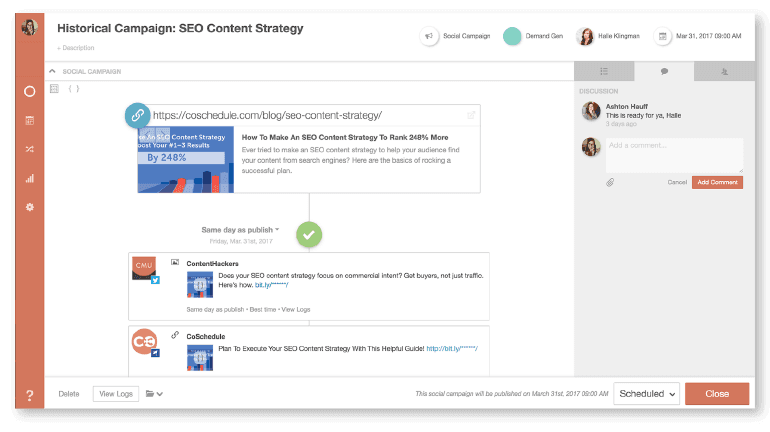 Source: https://www.getapp.com/marketing-software/a/coschedule/
It’s essential that content marketing and social media teams coordinate within planning software to share new content and suggest improvements to content distribution efforts.
With the right task management software, you can help ensure that your team is publishing content at the right cadence and giving readers a reason to return day after day, week after week.
Source: https://www.getapp.com/marketing-software/a/coschedule/
It’s essential that content marketing and social media teams coordinate within planning software to share new content and suggest improvements to content distribution efforts.
With the right task management software, you can help ensure that your team is publishing content at the right cadence and giving readers a reason to return day after day, week after week.
2. Compare Metrics and Engagement in Monthly Sessions
In addition to planning in a common task management tool, content marketing and social media teams should meet in person frequently to compare overall performance metrics and traffic wins and losses. Use these meetings to align objectives for the following month and quarter, and ensure that your business’s content marketing efforts are working. Frequent meetings can help uncover trends in performance and engagement and better align future content plans. With multiple team members working on various initiatives, big picture metrics can easily be forgotten or pushed aside. Keep your team focused on the end goal—whether that’s signups or conversions or something else—and make sure that everyone is working towards the same KPIs. Unsure where to start? Focus on overall site traffic (sessions or pageviews) from social platforms and the number of conversions through call-to-actions within blog content. To stay on track in these meetings, follow these steps.- Both teams should come prepared with wins, losses and overall metrics. Focus both on the metrics that relate to respective platforms (sessions, engagement, shares) as well as the long term goal metrics (sign-ups, conversions, sales).
- In the meeting, brainstorm on how both teams can better align goals, whether that means the social media team re-shares successful content multiple times, or content creates more pieces covering topics that Facebook users are eating up.
- Keep the conversation going throughout the month by sending a weekly round-up email with one big win and one big loss every Friday.
3. Target New Audiences Based on Engagement
So you’ve instituted a monthly metrics session—now what? Once you’ve begun to uncover trends and insights between platforms and on your blog, it’s time to put this data to work. Hone in on what’s working (and, of course, what’s not) and look for new audiences you can tap into.Once you’ve begun to uncover trends and insights between platforms and on your blog, it’s time to put this data to work.
Click To Tweet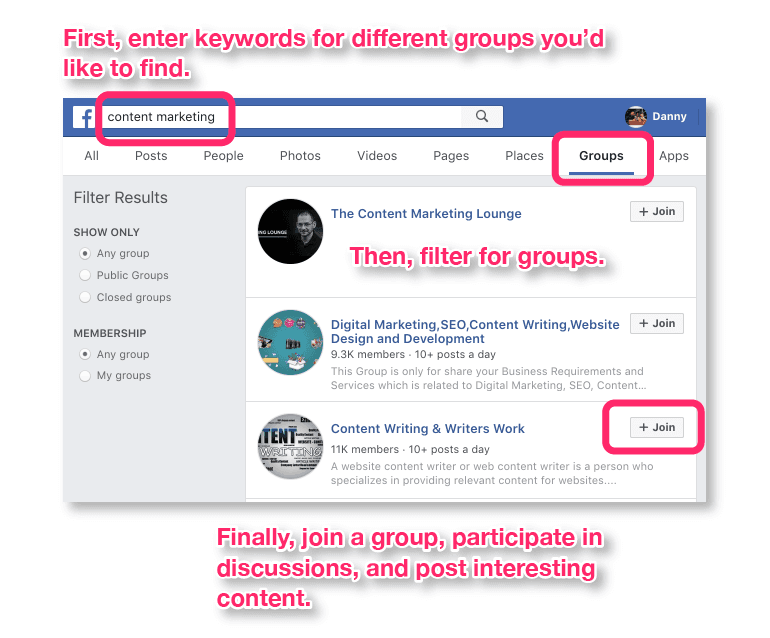 Step 2: On LinkedIn, the sidebar on the left-hand side of your homepage will display different relevant hashtags and new groups to explore. Use both of these tools to promote relevant content to new audiences.
Step 2: On LinkedIn, the sidebar on the left-hand side of your homepage will display different relevant hashtags and new groups to explore. Use both of these tools to promote relevant content to new audiences.
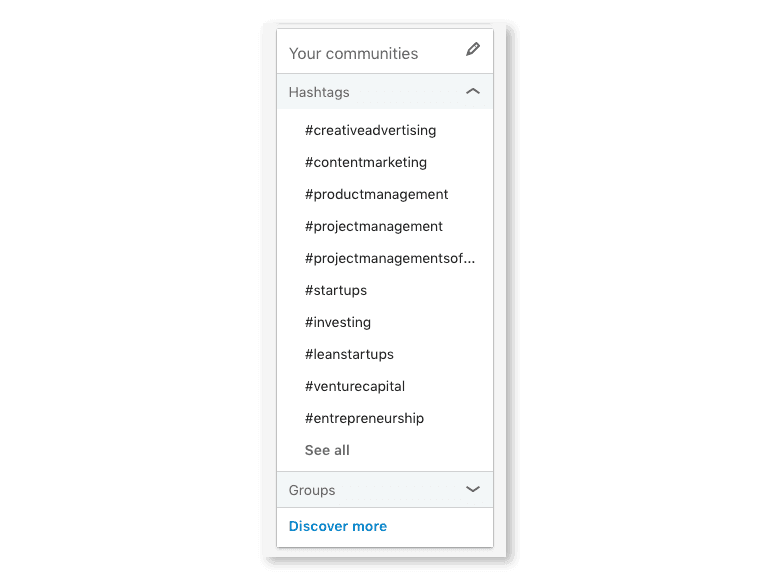 Step 3: On Twitter, add relevant, popular hashtags, like G2 Crowd did below to your tweets to increase engagement in new audiences.
Step 3: On Twitter, add relevant, popular hashtags, like G2 Crowd did below to your tweets to increase engagement in new audiences.
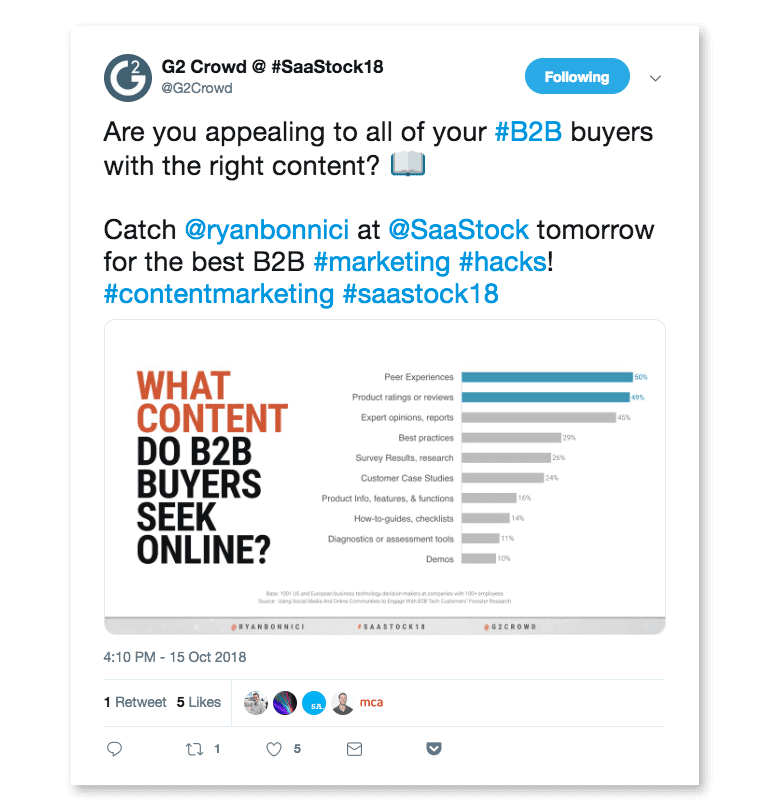 In turn, the blog can cover different topics that work specifically on Facebook or produce content in different formats like video, listicle, or slideshow depending on how they perform on new platforms.
When targeting new audiences, social media and content marketing teams should ensure that they don’t neglect their core audience in pursuit of expanding exposure to new niches or audience segments.
In turn, the blog can cover different topics that work specifically on Facebook or produce content in different formats like video, listicle, or slideshow depending on how they perform on new platforms.
When targeting new audiences, social media and content marketing teams should ensure that they don’t neglect their core audience in pursuit of expanding exposure to new niches or audience segments.
4. Creatively Market Content With Graphics or Clips on Social Media
One common content marketing tactic is to create e-books to thoroughly explain a topic, secure leads, or introduce a new product. These are longer form guides that can be key to increasing conversion, but they also take a lot of effort and time to produce, so it’s important to ensure that social is aligned before the work begins. Creating a series of graphics made specific for social media platforms can be a great way to promote an e-book or tease it’s release before it’s widely circulated. For example, if an upcoming e-book lists a number of steps for improving your business’s online security, you could design a colorful graphic for each step with a brief description. The release of these graphics daily will pique the interest of social media followers to download the e-book and read the rest of the steps. If there are no steps to list, excellent pull quotes from the e-book can be equally effective. With a tool such as Canva, you can access and edit great free designs in a couple of minutes, as I did below. Step 1: To get started, sign up for Canva and create your first design.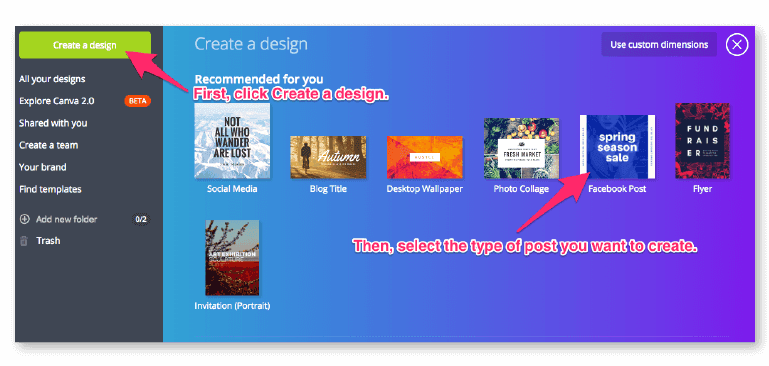 Step 2: Then select a layout and edit the text, background, and colors.
Step 2: Then select a layout and edit the text, background, and colors.
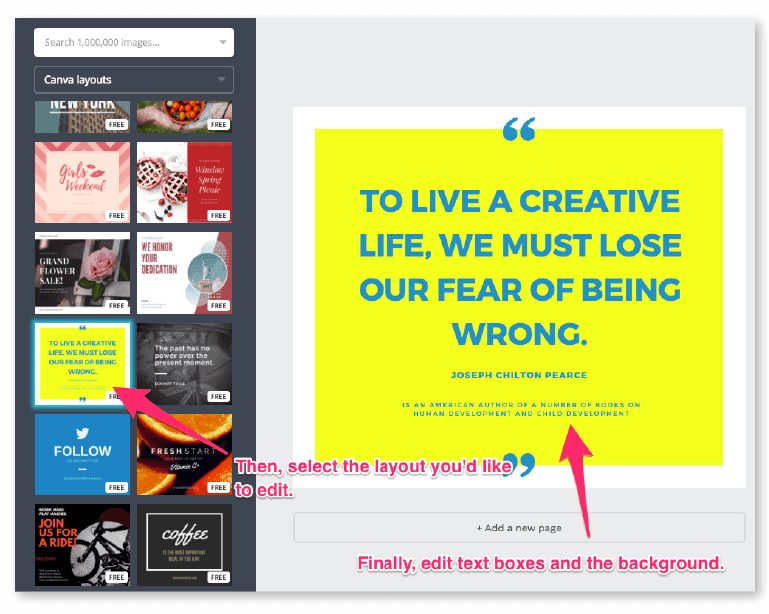 Step 3: Once your edits are complete, you’ll have a beautiful graphic to market your e-book.
Step 3: Once your edits are complete, you’ll have a beautiful graphic to market your e-book.
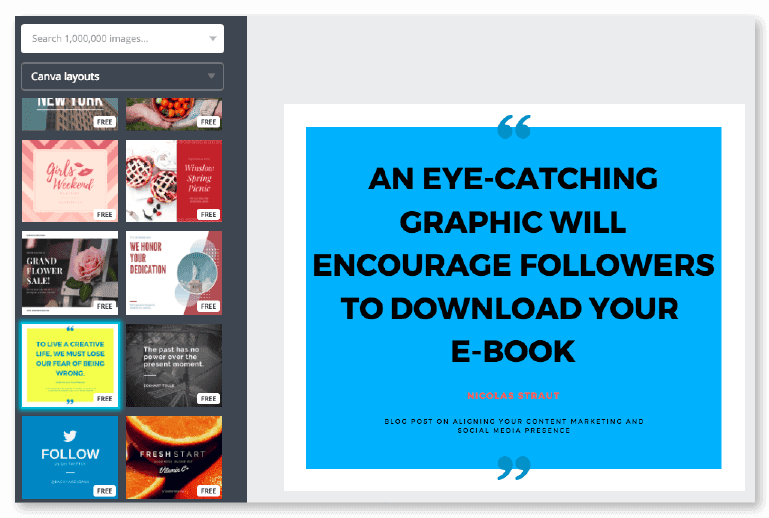 This tactic can be employed for YouTube or embedded videos as well by cutting a particularly good clip or a few clips from the video and releasing them on social media, and directing followers to a link if they’d like to watch the full video. On Facebook, this approach will yield many more views than a typical post because Facebook videos results in 135% more organic reach than photos, on average.
For best results, the content creator and social media team should coordinate on which steps, quotes, or clips would be best received by a social audience. With CoSchedule’s scheduling feature, you can determine and schedule posts at the best time for your audience.
This tactic can be employed for YouTube or embedded videos as well by cutting a particularly good clip or a few clips from the video and releasing them on social media, and directing followers to a link if they’d like to watch the full video. On Facebook, this approach will yield many more views than a typical post because Facebook videos results in 135% more organic reach than photos, on average.
For best results, the content creator and social media team should coordinate on which steps, quotes, or clips would be best received by a social audience. With CoSchedule’s scheduling feature, you can determine and schedule posts at the best time for your audience.
5. Integrate Popular Social Media Elements Into Blog Posts
One of the best aspects of online blogs, as opposed to traditional media, is the room for innovation and creativity in communicating information non-traditionally. For example, as emojis have gained widespread use in wordlessly communicating emotions through text messaging and social media, they have also gained use in blogs to spice up content. To stay ahead of the curve and keep up with new trends, social media teams should communicate to content marketers what social audiences respond well to and what can be implemented on blogs to keep content relevant and interesting.To stay ahead of the curve and keep up with new trends, social media teams should communicate to content marketers what social audiences respond well to.
Click To Tweet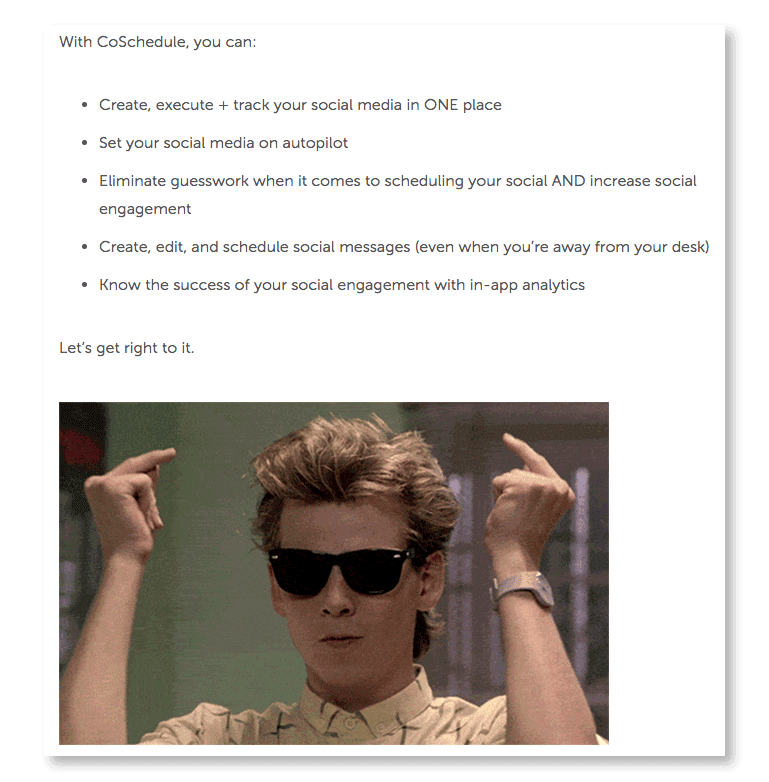 Of course, when applying any of these elements, content marketing teams should use discretion. For a more serious topic or professional guide, a meme or gif may not be appropriate. Likewise, a video or image slideshow could be distracting from core text or break the attention of the reader.
By testing engagement on both social media and in blog content with new elements, teams can safely innovate and stay ahead of the communication curve.
Of course, when applying any of these elements, content marketing teams should use discretion. For a more serious topic or professional guide, a meme or gif may not be appropriate. Likewise, a video or image slideshow could be distracting from core text or break the attention of the reader.
By testing engagement on both social media and in blog content with new elements, teams can safely innovate and stay ahead of the communication curve.
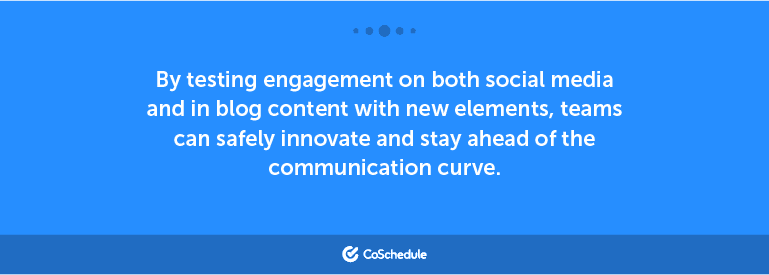
6. Use Blog Content for Facebook Live Material
You can’t get it right every single time. One of the unfortunate facts of creating content is that many of the posts you create may go unseen. But consider this—a post that didn’t quite work in one form could be repurposed and utilized in a whole different way. For example, a blog post that didn’t quite catch on in written form could be turned into a video script and presented to a Facebook or Instagram Live audience. Another example could be taking steps from a blog post, creating graphics from it, and uploading them as a slideshow on Instagram to be flipped through. Step 1: To get started, select the right blog post that would be interesting to your Facebook audience. Step 2: Choose parts of the post that could be succinctly summarized in a 15-minute Facebook Live. Look for clear steps that are actionable and easy to describe. Once found, write a script with an introduction, the subjects you’d like to cover, and a conclusion.
Step 2: Choose parts of the post that could be succinctly summarized in a 15-minute Facebook Live. Look for clear steps that are actionable and easy to describe. Once found, write a script with an introduction, the subjects you’d like to cover, and a conclusion.
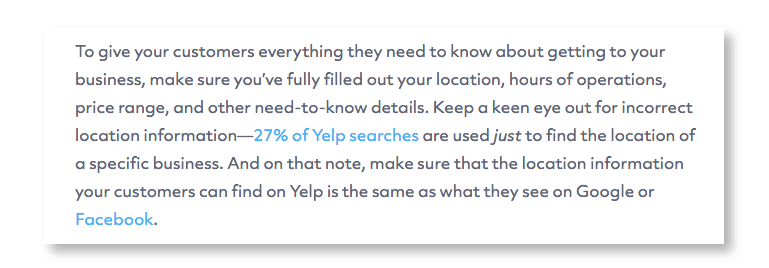 Step 3: Promote the Facebook Live on different social media accounts.
Step 3: Promote the Facebook Live on different social media accounts.
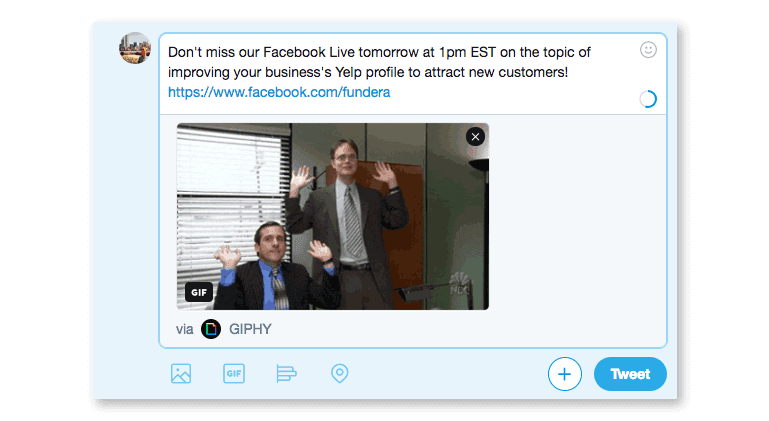 Step 4: To launch the Facebook Live, go to your Facebook page and click ‘Live’ in the action panel.
Step 4: To launch the Facebook Live, go to your Facebook page and click ‘Live’ in the action panel.
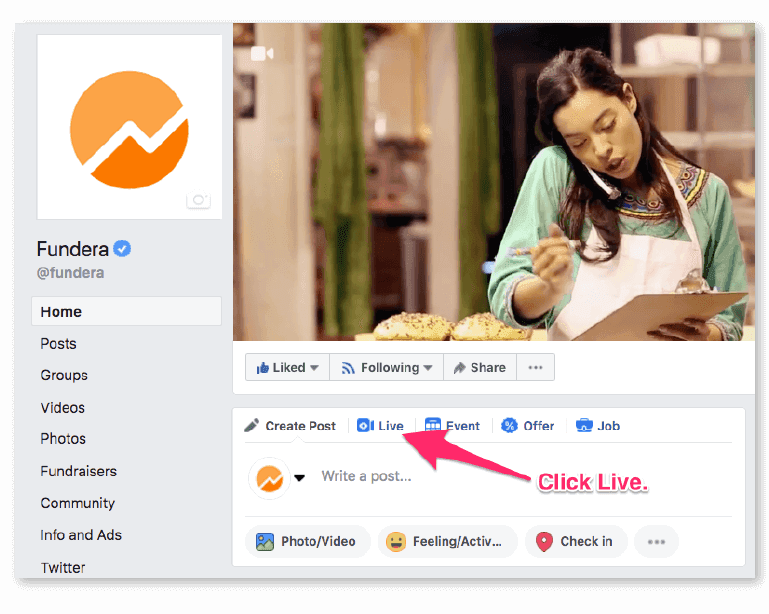 Though you can’t make every single post work, it’s a good idea to narrow in on blog posts that you’d like to give a little more “juice” to. Task social media teams to come up with ideas that could work based on existing content and work from there. If you want to do a Facebook Live, consider whether you have relevant content you can reference in the chat or edit to make a scrip.
Don’t look at low clicks as a failure—look at it as an opportunity to innovate and improve.
Though you can’t make every single post work, it’s a good idea to narrow in on blog posts that you’d like to give a little more “juice” to. Task social media teams to come up with ideas that could work based on existing content and work from there. If you want to do a Facebook Live, consider whether you have relevant content you can reference in the chat or edit to make a scrip.
Don’t look at low clicks as a failure—look at it as an opportunity to innovate and improve.

7. Launch a Cross-Promotional Content Series Across Channels
One great way to increase engagement across all channels and create a cohesive content marketing experience is to launch a series that can work across many platforms. For example, a new content vertical could launch in conjunction with a YouTube series that’s also cut down shorter snippets for Facebook. Say your goal is to gain YouTube subscribers for a new account— you could plan a content series that embeds a new YouTube video in every post, enticing readers to click through and (hopefully) subscribe. Neil Patel, an expert on digital marketing, promotes across multiple channels including YouTube, e-books, blog posts, and social media, which has made his name omnipresent in the marketing space. If you’re building a presence on YouTube and have a popular blog, try the following tactic that Patel utilized. Step 1: After creating a couple videos for YouTube, write a comprehensive blog post on a complementary topic. For example, Neil wrote a blog post explaining that everything he has taught about SEO was wrong: Step 2: Then, embed the YouTube video, which is a natural next step in the blog post’s call-to-action into the near end of the blog post. This will encourage readers to watch the video, increasing your viewership, and perhaps then watch the next video in sequence or even, subscribe to your channel!
Step 2: Then, embed the YouTube video, which is a natural next step in the blog post’s call-to-action into the near end of the blog post. This will encourage readers to watch the video, increasing your viewership, and perhaps then watch the next video in sequence or even, subscribe to your channel!
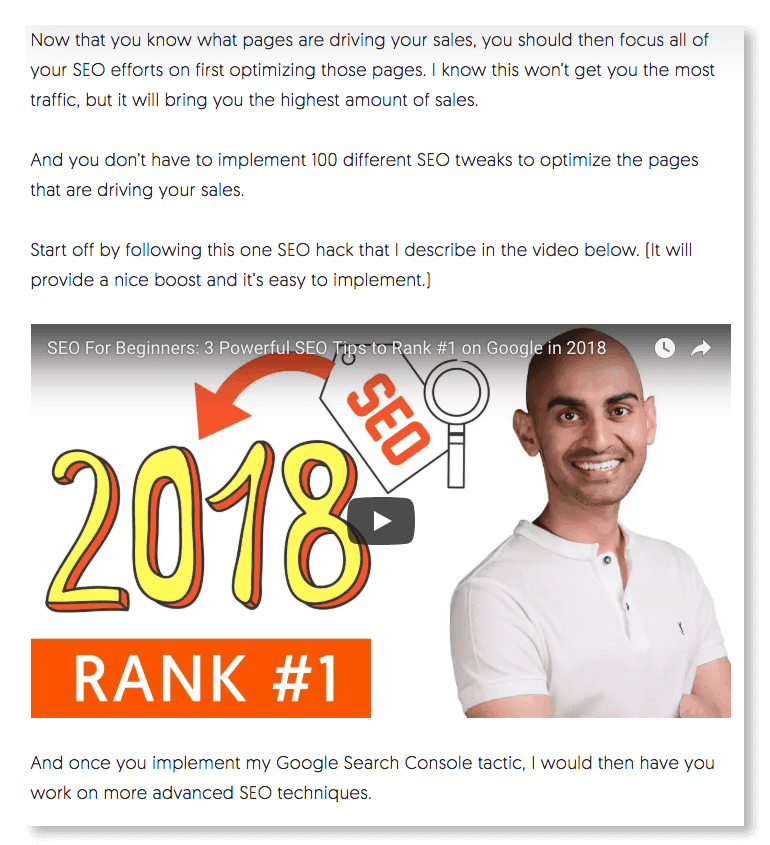 To promote an e-book or report, a social media team could release a series of videos on Facebook or Twitter explaining aspects of the e-book or report’s findings with attached links to the piece of content itself. In addition, selections from the content could be published on LinkedIn either under the brand or executives’ profiles with links to the content included.
To promote an e-book or report, a social media team could release a series of videos on Facebook or Twitter explaining aspects of the e-book or report’s findings with attached links to the piece of content itself. In addition, selections from the content could be published on LinkedIn either under the brand or executives’ profiles with links to the content included.
8. Use Top Writers for Twitter Chats, Reddit AMAs, and Quora
Twitter chats (public conversations within a unique hashtag) are excellent ways to interact with other companies in your space, gain followers, and assert your brand as a thought leader on a specific subject. Likewise, a Reddit AMA (Ask Me Anything), where executives answer common questions about a topic or the company itself, is an excellent tactic to increase engagement and publicity in a niche community. For upcoming chats and AMAs, social media teams should coordinate with writers or company executives to ensure they’re on hand when questions begin to roll in and to provide comprehensive responses that wow participants. Tap into your blog to come up with new topics to cover and angles to take.
Quora, a platform where users ask and answer questions, is another place where social media and content marketers should coordinate engagement. For the sake of optics on Quora, it can be better if individuals at a company create an account and answer questions, rather than brands. The writers who handle the blog can be excellent resources to answer questions and provide invaluable insight.
Step 1: After signing up for a Quora account, a writer simply must answer a few questions in their niche before Quora and other users begin asking them for other answers. Once in your account, click Answer to find the right question.
For upcoming chats and AMAs, social media teams should coordinate with writers or company executives to ensure they’re on hand when questions begin to roll in and to provide comprehensive responses that wow participants. Tap into your blog to come up with new topics to cover and angles to take.
Quora, a platform where users ask and answer questions, is another place where social media and content marketers should coordinate engagement. For the sake of optics on Quora, it can be better if individuals at a company create an account and answer questions, rather than brands. The writers who handle the blog can be excellent resources to answer questions and provide invaluable insight.
Step 1: After signing up for a Quora account, a writer simply must answer a few questions in their niche before Quora and other users begin asking them for other answers. Once in your account, click Answer to find the right question.
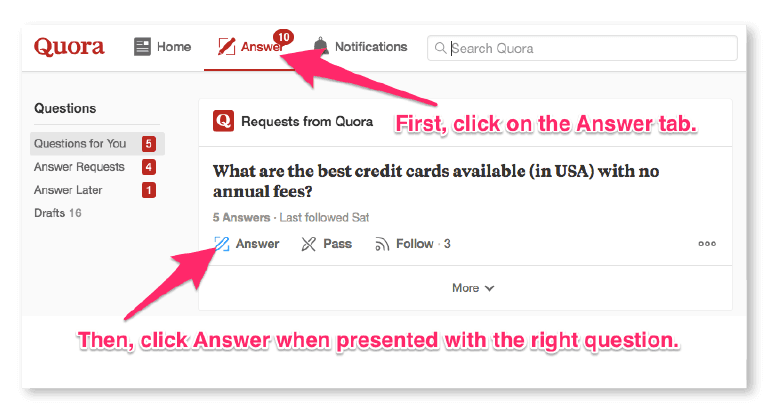 Step 2: Write your answer and click submit. Try different answer formats like steps and lists, adding useful images, and making your responses long and comprehensive to receive recognition and upvotes.
Step 2: Write your answer and click submit. Try different answer formats like steps and lists, adding useful images, and making your responses long and comprehensive to receive recognition and upvotes.
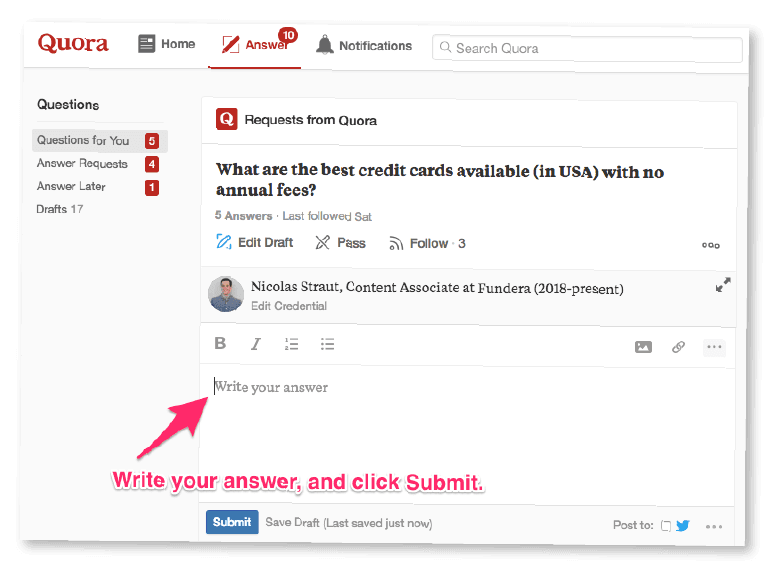
9. Originate New Content Ideas From Social Media Followers and Polls
Social media followers who regularly interact with content are often a brand’s most engaged audience with untapped feedback to provide. To come up with creative new ideas for content creation, poll your social audiences with direct questions about topics they’d like covered or content mediums they like most.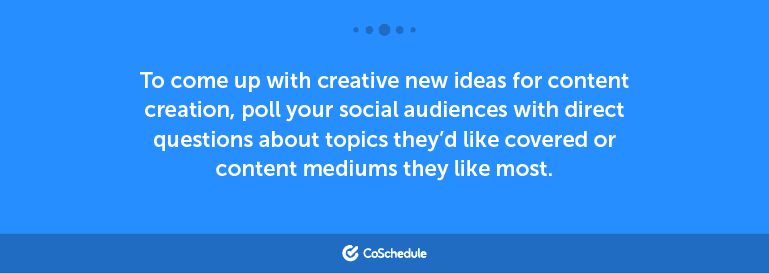 Step 1: To poll followers on Twitter, add your question then click Add poll.
Step 1: To poll followers on Twitter, add your question then click Add poll.
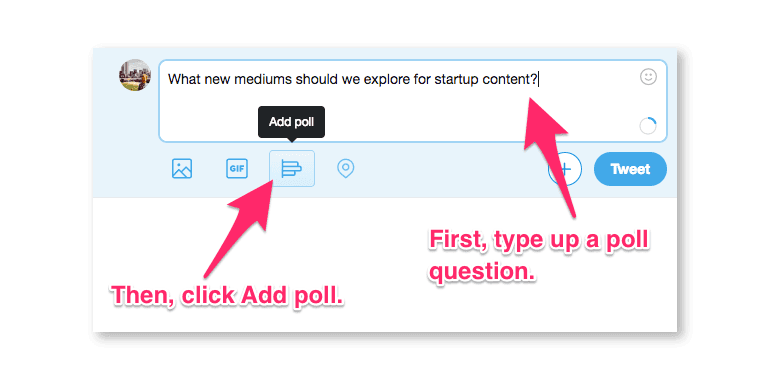 Step 2: Add poll answer options and click Tweet.
Step 2: Add poll answer options and click Tweet.
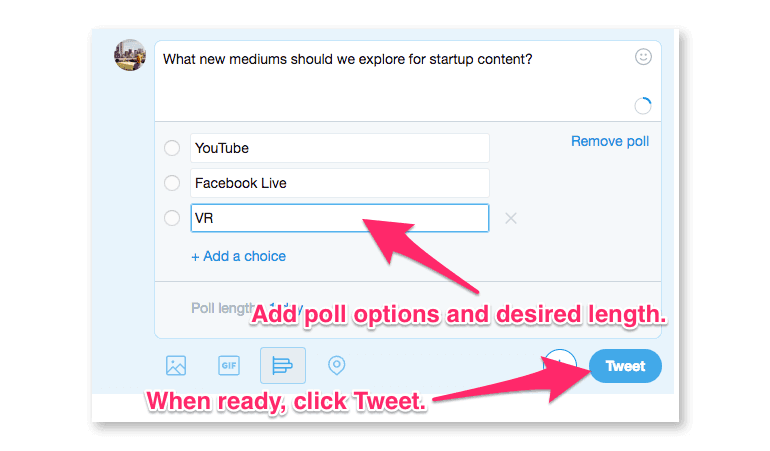 Integrating more polls and surveys is a great way to plan future content and gather meaningful feedback from those who are more dedicated to your brand.
Integrating more polls and surveys is a great way to plan future content and gather meaningful feedback from those who are more dedicated to your brand.
Integrating more polls and surveys is a great way to plan future content and gather meaningful feedback from those who are more dedicated to your brand.
Click To Tweet

